The subtropical climate of Florida is an ideal greenhouse-like environment for plants. Compared to most areas of the U.S., the climate is temperate-to-warm year-round. Additionally, humidity is high, rainstorms are frequent, and sunshine is abundant. At the same time, ocean breezes from the Gulf of Mexico and the Atlantic help keep things pleasant.
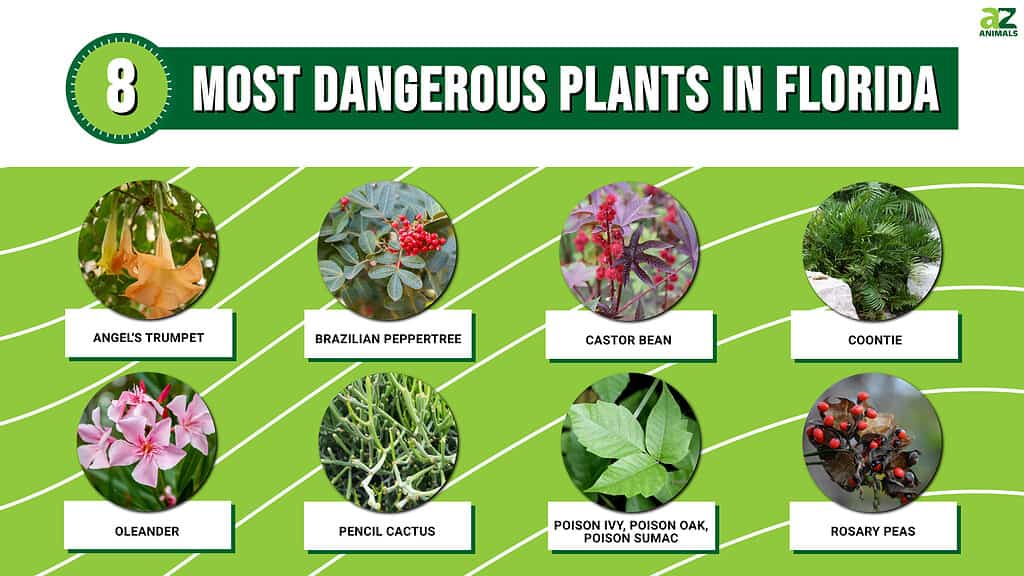
When you visit Southern Florida, don’t be surprised to see otherwise small plants growing into gigantic shrubs and even trees. Unfortunately, some of those plants can be deadly to people or pets. Read on to discover some of the most dangerous plants in Florida to protect yourself and your family.
Even non-Florida residents might want to read on to discover whether any of these are growing in your garden.
What Makes a Plant Dangerous?
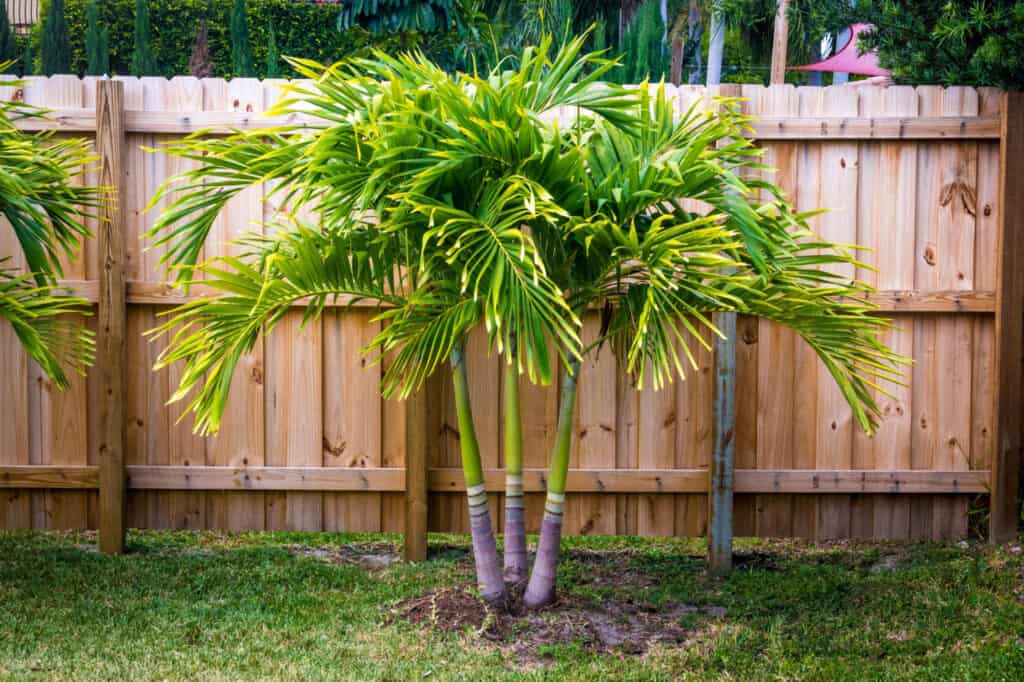
Florida is a plant lover’s dream! But be sure you know what’s safe and what’s not for you, your children, and your pets.
©julie deshaies/Shutterstock.com
Plants sometimes have defenses that prevent them from being wantonly eaten or trampled down. These can pose a danger to people and pets in several ways. For example:
- Poisons: some plants can be toxic when parts of the plant, such as leaves, fruit, or seeds, are eaten. They might cause an upset stomach, organ damage, or even death if eaten in large enough quantities.
- Allergies: many plants reproduce through pollination. People who have pollen allergies may experience mild to severe sneezing, congestion, and problems breathing. Plants can also secrete oils that may irritate skin – sometimes severely. Poison ivy is an example.
- Thorns and spikes: plants like cacti or roses can inflict puncture wounds and scratches. These can create injuries that become infected.
- Aggressive growth: some introduced species, like kudzu, can rapidly overtake property and kill out other vegetation. Even if not physically dangerous, they can be destructive and should be removed immediately from your property.
In this article, we’ll point out some plants that pose such a danger. If they’re in your garden, you’ll probably want to get rid of them.
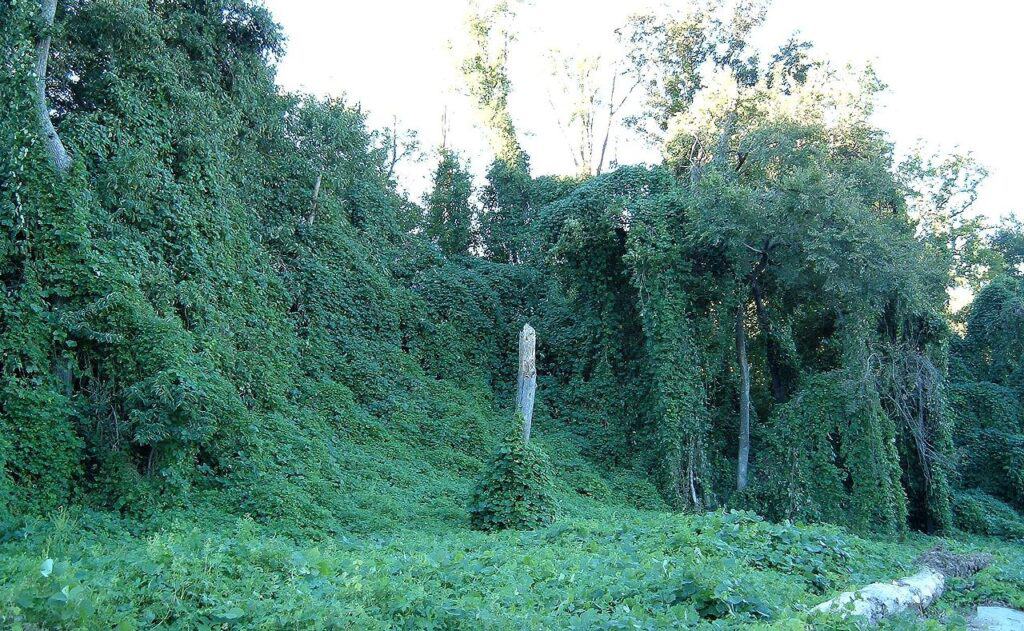
Kudzu is a rapidly growing invasive vine in the Southern United States that, if not controlled, can cover entire landscapes.
©Scott Ehardt / public domain – License
The Most Dangerous Plants in Florida
Florida has quite a few dangerous plants that hurt or even kill humans or pets. We’ve selected some of the worst below. If you have any of these in your garden, continue reading for tips on how to get rid of them.
Angel’s Trumpet
Angel’s trumpet is a South American tropical tree that blooms with beautiful trumpet-shaped flowers. Some varieties have no scent, while others have a variety of scents that can be overpowering. They can grow up to 30 feet tall outdoors in tropical and subtropical climates like that of Florida. There’s so much to like about this plant, you might be tempted to cultivate it yourself. However, maybe you should resist that urge.
Angel’s trumpet is part of the nightshade family and is considered to be one of the most toxic ornamental shrubs. If consumed, the flowers and seeds can cause hallucinations and violent seizures that can be fatal. If you do choose to cultivate this plant, keep children and pets away from it. Use gloves if you must handle it.
It is also not recommended to include any part of this plant in your compost. This might spread toxins to other parts of your garden.
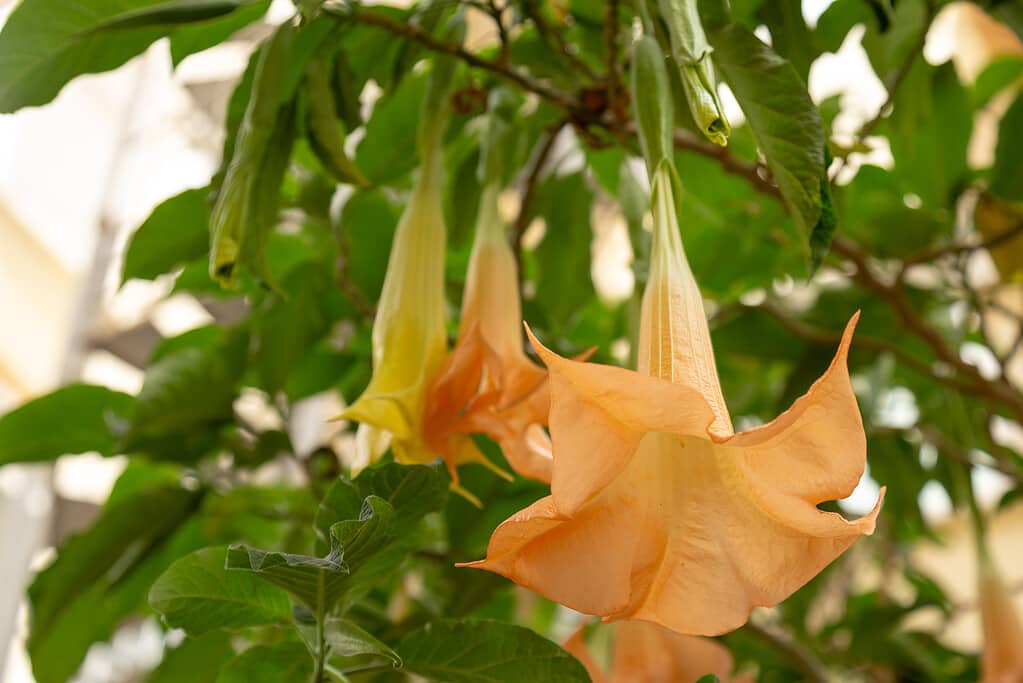
Angel’s trumpet is part of the nightshade family and is considered to be one of the most toxic ornamental shrubs.
©Iurii Garmash/iStock via Getty Images
Brazilian Peppertree
Brazilian pepper is an invasive species first imported for decorative purposes. Now it is one of the most dangerous plants in Florida, covering some 700,000 acres of land. It is often found along roads and highways. It has proven to be one of the most difficult and tenacious invasive plants in the Everglades. And it can thrive on dry land or in swampy environments equally well.
This peppertree is in the same botanical family as poison ivy, poison oak, and poison sumac. But unlike those species, Brazilian pepper can grow into a tree 30 feet tall. It grows rapidly, sinks deep roots, and makes a dense canopy. This canopy blocks sunlight from other species and reduces the biodiversity of the flora in the area.
As with related species such as poison ivy, touching the leaves can create blisters and an intensely itchy rash. Breathing difficulty may develop if smoke from burning plants is inhaled. Moreover, its seeds will kill birds.
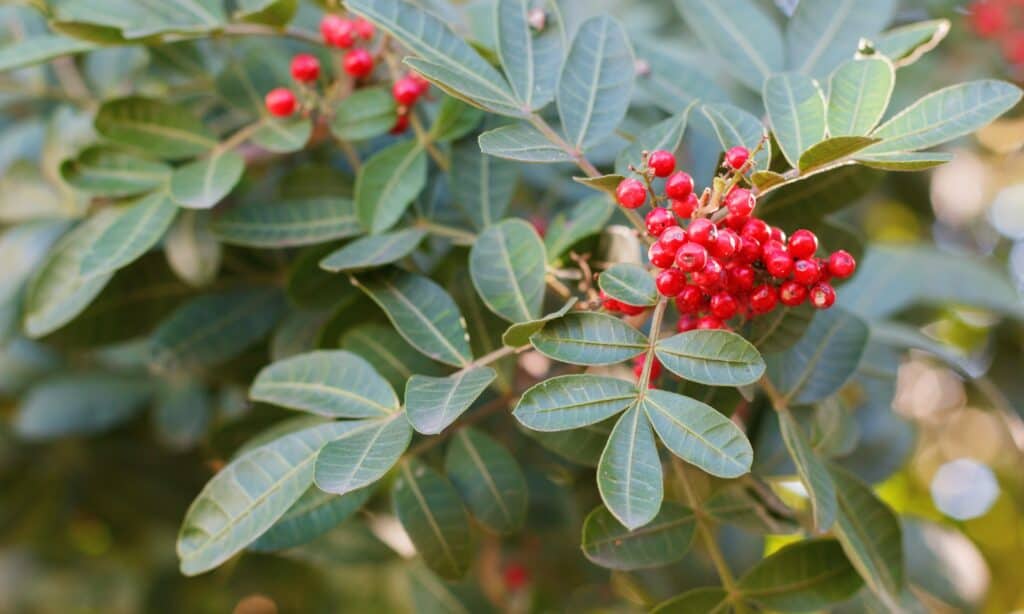
Brazilian peppertree irritates skin like poison ivy, produces bird-killing seeds, and hogs sunlight from other plants.
©iStock.com/jantroyka
Castor Bean
The castor bean plant grows as a tall shrub with large green or red-purple leaves. They produce spiky green seed pods with shiny seeds inside. Castor beans contain ricin, a toxin more poisonous than cobra venom or cyanide. If castor beans are chewed or swallowed, they can cause sleepiness, nausea, bloody vomiting, diarrhea, internal organ damage, and death. This truly is one of the most dangerous plants in Florida! If this plant is anywhere on your property, you’re well advised to remove it and dispose of it safely.
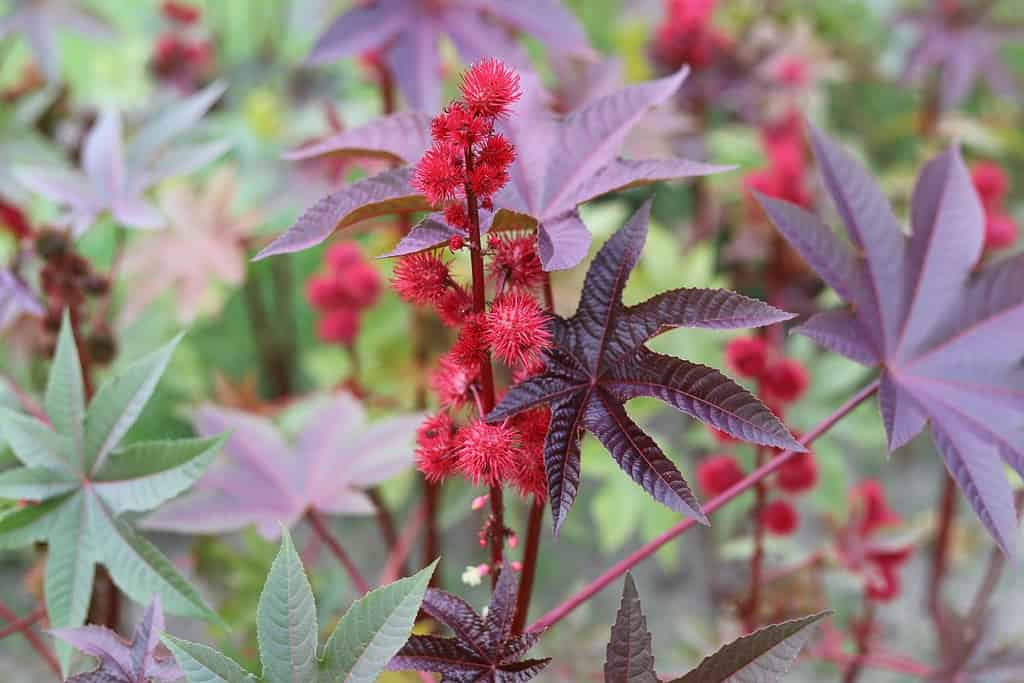
If castor beans are chewed or swallowed, they can cause sleepiness, nausea, bloody vomiting, diarrhea, internal organ damage, and death.
©Kabar/Shutterstock.com
Coontie
Coontie is an indigenous Florida plant with light green, leathery leaves that emerge from an underground root. It is a low-growing plant that is easily accessible to children and pets, and it produces tempting orangey-red seeds. Some animals, birds, and insects feed on the seeds without a problem, but they are poisonous to people. Interestingly, native Americans of the Seminole tribe were able to prepare the roots and stems to remove the toxins. Since most of us don’t have that knowledge . . . don’t eat coontie.
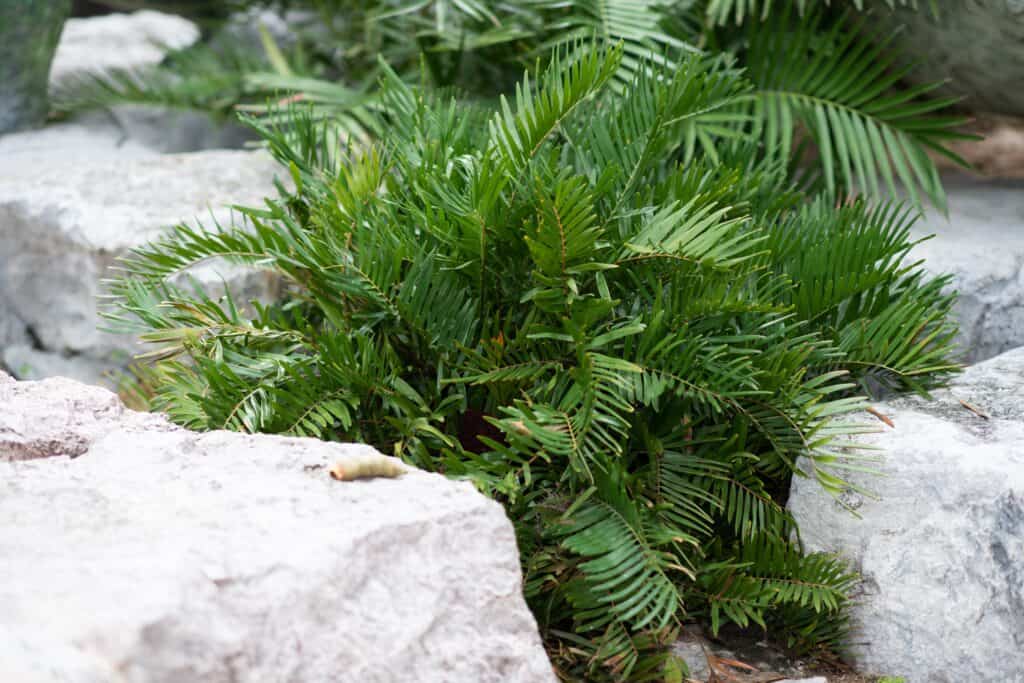
Coontie seeds are poisonous to humans.
©Fern plam leaves/Shutterstock.com
Oleander
Oleander is a shrub or small tree with glossy dark green leaves arranged in whorls along the plant’s stem. When it blooms, it has clusters of pink, white, or red flowers. Every part of this plant is poisonous, causing immediate pain when chewed. Symptoms include painful burning and irritation of the lips, mouth, and throat, followed by nausea if the plant is swallowed.
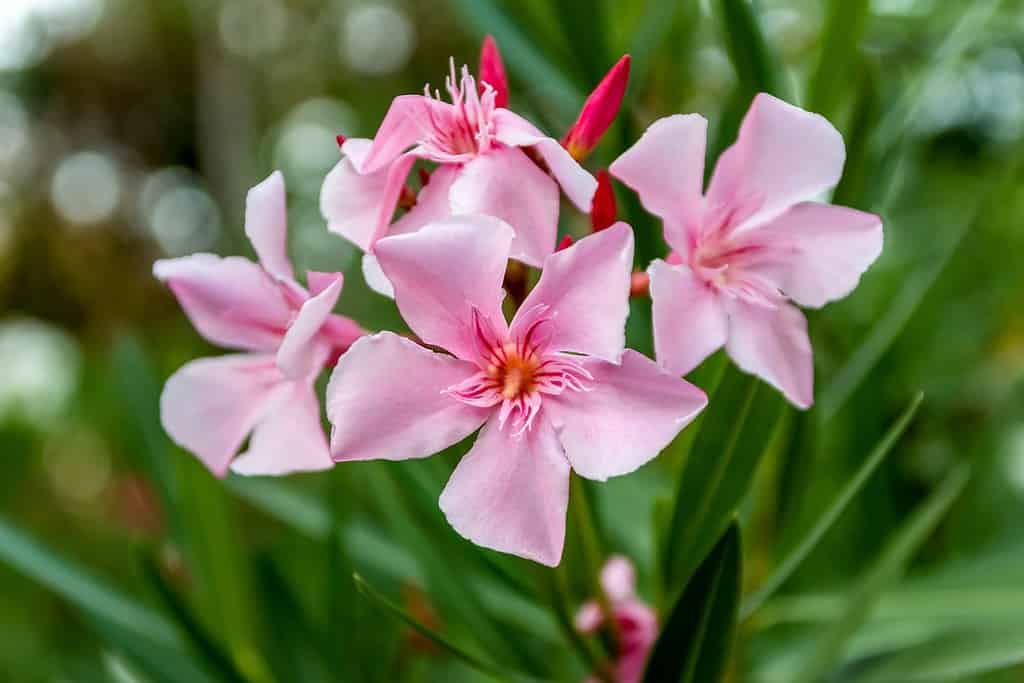
Every part of the oleander plant is poisonous, causing immediate pain when chewed.
©Dmitrii Brodovoi/Shutterstock.com
Pencil cactus
Pencil cactus is also known as milk bush, Indian tree spurge, pencil bush, and pencil tree. This African native is a succulent that can grow up to fifteen feet tall. It exudes a white milky sap that is highly toxic and irritating to the skin. In India, it is used by fishermen to poison fish.
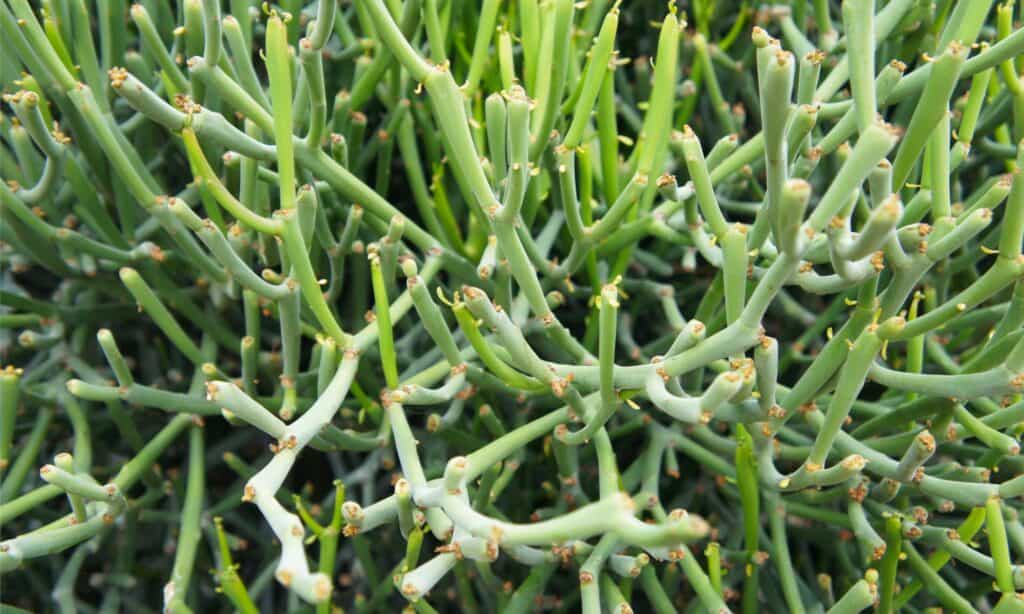
Pencil cactus plants produce a highly toxic white sap that is irritating to the skin.
©iStock.com/skymoon13
Poison Ivy, Poison Oak, Poison Sumac
Poison ivy and poison oak have similar appearances and effects, but they have a couple of differences. The notorious poison ivy grows as a vine and has smooth leaves. Conversely, poison oak tends to grow as a shrub and has lobed and hairy leaves. Both have leaves divided into three leaflets, leading to the old expression, “leaves of three, let it be.” Poison sumac differs from the other two in that it grows as a tall shrub. It has leaves arranged in pairs along its stems.
All three plants have the same defense mechanism: an oily secretion that causes a painful, itchy, blistering rash. Some people are more sensitive to it than others, but you don’t want to find out! The itching is maddening and scratching can spread the reaction to other parts of the body and to other people.
In this way, an unmonitored child can quickly spread a small reaction all over his body and to siblings. The smoke of burning poison ivy or poison oak can cause similar skin irritation. It can even get into the lungs and cause breathing problems.
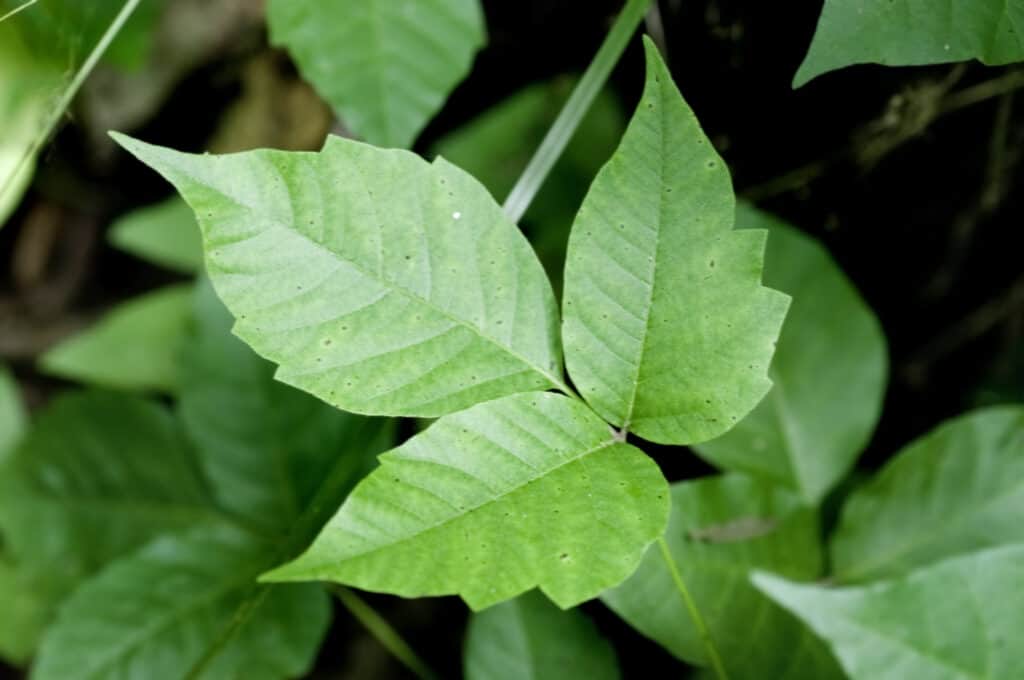
Poison ivy creates extreme skin irritation that can spread all over the body if the affected person scratches at the rash and blisters.
©Tim Mainiero/Shutterstock.com
Rosary Peas
Rosary peas are native to India but have been used all over Florida as an ornamental plant. They have beautiful fern-like leaves, delicate blooms, and seed pods that open to reveal bright red, berry-like, hard-shelled seeds.
In traditional societies, their hard berries are sometimes strung together to make necklaces or other jewelry or used in musical instruments. However, they are now recognized in Florida and many other parts of the world as extremely dangerous invasive species.
Their roots run deep and are hard to dig out. They can cling to other plants and over-grow them. And most disturbingly, swallowing a single berry is enough to kill a dog, cat, human being, or even an animal as large as a horse (birds are not affected, so they are big culprits in helping to spread the seeds). Fortunately, if the berry is swallowed whole, the hard coating is sometimes able to keep the poison contained until the berry can pass undigested and be expelled in feces.
But if the berry is chewed, or crushed, or if the hard surface was scratched, it can cause nausea, convulsions, liver failure, and death after several days.
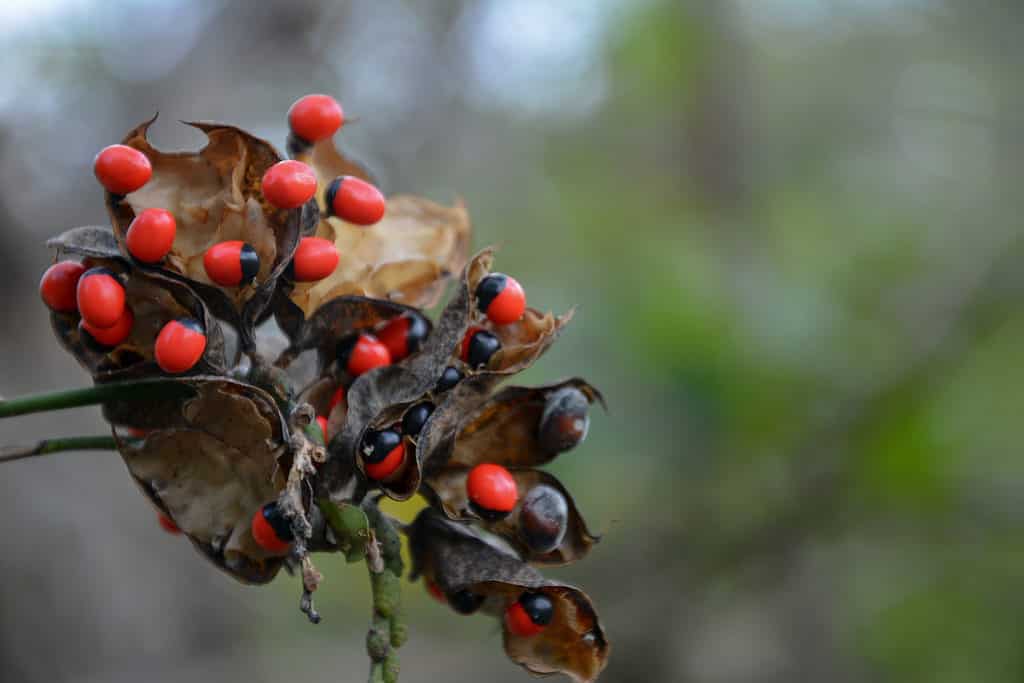
The rosary pea plant has highly toxic red berries. A single berry can kill a human being. Obviously one of the most dangerous plants in Florida.
©Kuganathan Priyatharsan/Shutterstock.com
What Do You Do If Someone is Exposed to Plant Toxins?
If, despite your best efforts, one of your family members or pets was exposed to a harmful plant, here are some suggested emergency steps:
- If the plant was ingested by a person, call 911 or a poison control center for a person, or call an emergency vet for your pet. Do not induce vomiting without consulting a medical professional.
- Make sure they are breathing, and their airway is not blocked. Remove any plant material from the mouth or affected area.
- Try to identify the source of the plant. Was it a houseplant or something outside? Take a picture of it if you are not sure what it is look it up online and provide it to medical professionals.
- Monitor the affected person or pet for symptoms such as a rash, blistering, swelling, nausea, hallucinations, difficulty breathing, or other signs of distress.
Suggestions for Removing Dangerous Plants
Taking the preventative step of removing dangerous plants from your property is advisable to protect people and animals who might be hurt by them and to help stop them from spreading further. (Remember birds, animals, and the weather may disburse seeds far and wide from your yard.)
A horticultural specialist can give you the best advice about how to handle dangerous plants, but if you plan to do it yourself, here are some general tips to help protect yourself:
- Wear protective clothing with long sleeves, long pants, and gloves to protect your skin.
- Don’t scratch at or wipe your face while working on this project.
- Cut the plant all the way to the ground with pruning shears or a saw.
- Dig up as much of the root system as you possibly can to prevent the plant from returning.
- Do not compost the plant. Put it in one or more sealed plastic bags and dispose of it with your garbage.
- Hire a professional tree service for large plants or trees.
Now that you know about some of the most dangerous plants in Florida, are you interested in learning about dangerous plants in other parts of the United States? Check out this article: Discover the Most Dangerous Plants in the United States.
Summary of the Eight Most Dangerous Plants in Florida
Here is a list of the eight most dangerous plants in Florida:
| Rank | Plants |
|---|---|
| 1 | Angel’s trumpet |
| 2 | Brazilian Peppertree |
| 3 | Castor Bean |
| 4 | Coontie |
| 5 | Oleander |
| 6 | Pencil cactus |
| 7 | Poison Ivy, Poison Oak, Poison Sumac |
| 8 | Rosary Peas |
The photo featured at the top of this post is © iStock.com/simonapilolla
Thank you for reading! Have some feedback for us? Contact the AZ Animals editorial team.






